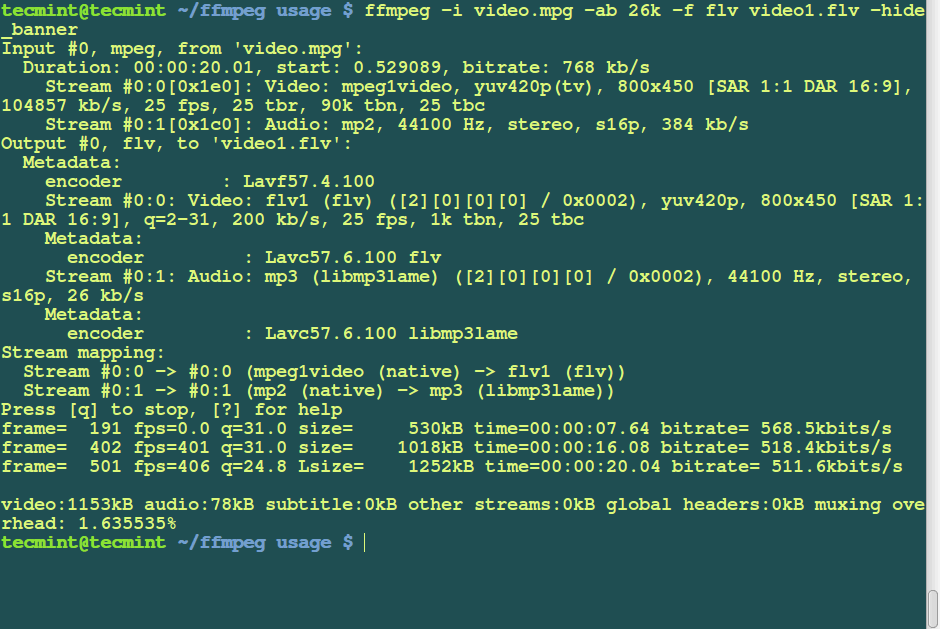

- #FFMPEG CONVERT FRAME RATE AND SPEED MOVIE#
- #FFMPEG CONVERT FRAME RATE AND SPEED CODE#
- #FFMPEG CONVERT FRAME RATE AND SPEED DOWNLOAD#
- #FFMPEG CONVERT FRAME RATE AND SPEED FREE#
The GIF file format was never intended to be used for animation or video. How GIFs Became Pseudo Videos in the First Place Inverse Fourier Transform of an Image with low pass filter: cv2.In this post, I’ll show you just how easy it is to convert GIFs to HTML5 video and achieve incredibly small file sizes for your site. Signal Processing with NumPy II - Image Fourier Transform : FFT & DFT Signal Processing with NumPy I - FFT and DFT for sine, square waves, unitpulse, and random signal OpenCV 3 image and video processing with Python The core : Image - load, convert, and save
#FFMPEG CONVERT FRAME RATE AND SPEED FREE#
Sponsor Open Source development activities and free contents for everyone. The following iframes are from Vimeo: Twin Peaks San Francisco Sunrise (HDR time-lapse):
#FFMPEG CONVERT FRAME RATE AND SPEED CODE#
The code not only works for Youtube but also works for Viemo. Source code is available from Github ( FFMpeg/iframe_extract.py)

Parser = argparse.ArgumentParser(description='download video') # so, in this case, we want to rename it 'out.webm' # Sometimes output file has format code in name such as '' # video_out = ''.join(c for c in meta if c.isalnum()) + '.'+ metaĬmd = # remove non-alpha-numeric such as ' ', '(', etc. With youtube_dl.YoutubeDL(ydl_opts) as ydl:
#FFMPEG CONVERT FRAME RATE AND SPEED DOWNLOAD#
# Get video meta info and then download using youtube-dl Mvcmd = 'mv ' + imgPrefix + '*.png ' + imgPrefix # imgPrefix is used as a subfolder name that stores iframe images # Move the extracted iframes to a subfolder "select='eq(pict_type,PICT_TYPE_I)'",'-vsync','vfr', imgFilenames] # (ex) 'FoxSnowDive-Yellowstone-BBCTwo.mp4' # "select='eq(pict_type,PICT_TYPE_I)'" -vsync vfr oString%03d.png Iframe_extract.py - download video and ffmpeg i-frame extraction After downloading a video, it extracts iframes and store them subfolder that named after the video file name: But the code below includes the video download from YouTube. This is not much different from previous samples. Note: in my case, the ffmpeg command is in ~/bin directory. # ffmpeg -i inFile -f image2 -vf "select='eq(pict_type,PICT_TYPE_I)'" -vsync vfr oString%03d.png

"python iframe.py -i yosemite.mp4 -o yos" will output 'yos001.png', 'yos002.png', and so on."python iframe.py -i yosemite.mp4" will output 'out001.png', 'out002.png', and so on.It's using the following ffmpeg command:įfmpeg -i inFile -f image2 -vf "select='eq(pict_type,PICT_TYPE_I)'" -vsync vfr oString%03d.png Input is required, but output is optional. The following python code extracts i-frames. The bigger the seeking time is, the longer you will have to wait. The advantage is that we'll get the frame at the right time, but the drawback is that it will take a lot of time until it finally reaches that time point. This will be done very slowly, frame by frame. In this case, the input will be decoded until it reaches the position given by -ss. However, in our example, since we did put -ss after -i, it produced one image frame precisely at the requested time from the beginning of the movie. The drawback is that it will also finish the seeking at some keyframe, not necessarily located at specified time (00:00:18.123), so the seeking may not be as accurate as expected. The input will be parsed using keyframes, which is very fast. If the -ss comes before -i, it will also produce one image frame (yosemite.png) somewhere around the 18 seconds from the beginning of the movie.
#FFMPEG CONVERT FRAME RATE AND SPEED MOVIE#
The command will seek to the position of 0h:0m:18sec:123msec into the movie and extract one frame (-vframes 1) from that position into a yosemite.png file: When we extract just one frame, we can opt out "-f image2" from the command above:įfmpeg -i yosemiteA.mp4 -ss 00:00:18.123 -frames:v 1 yosemite.png


 0 kommentar(er)
0 kommentar(er)
